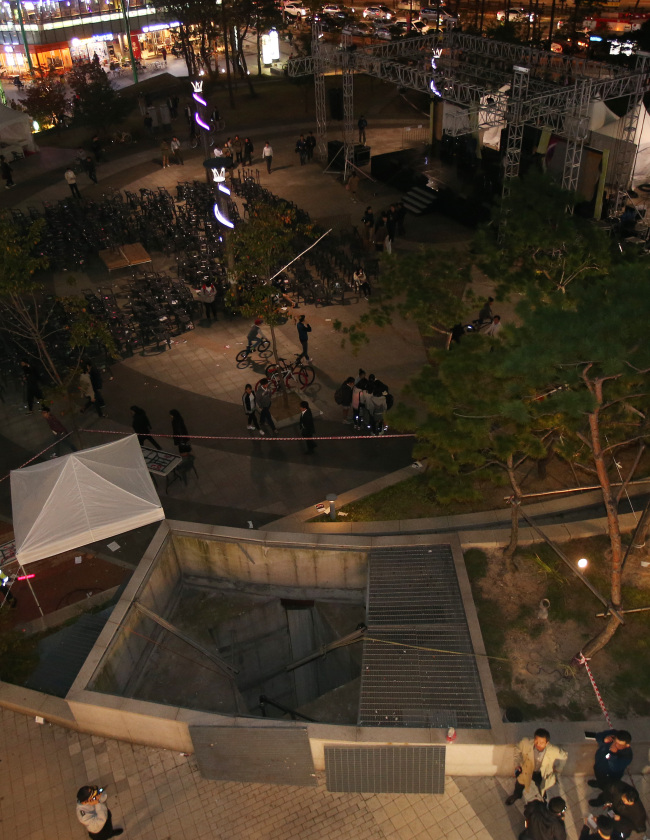[Newsmaker] Vent shafts accidents waiting to happen
By Korea HeraldPublished : Oct. 19, 2014 - 21:18
The innumerable ventilation shafts around the country may be accidents just waiting to happen, with no regulations to ensure their structural integrity.
With thousands of ventilation shafts, covered by metal grates, located in Seoul alone, their construction is subject to almost no safety regulation, often leaving it up to the construction companies to build according to their internal regulations.
The related construction regulation simply states that the ventilation outlet should be located 2 meters or more above the road surface. The clause makes no other mention of standards regarding structural aspects of such constructs other than the need to use corrosion resistant materials.
In Friday’s incident, 27 people were standing on grates covering a ventilation shaft of an underground parking lot. The grates and the structure supporting them gave way under the weight of the spectators, plunging them to the parking lot at a distance equivalent to four stories. As a result, 16 people died and 11 are still undergoing treatment. Of the injured, eight are in critical condition, fueling concerns that the death toll may rise.
With thousands of ventilation shafts, covered by metal grates, located in Seoul alone, their construction is subject to almost no safety regulation, often leaving it up to the construction companies to build according to their internal regulations.
The related construction regulation simply states that the ventilation outlet should be located 2 meters or more above the road surface. The clause makes no other mention of standards regarding structural aspects of such constructs other than the need to use corrosion resistant materials.
In Friday’s incident, 27 people were standing on grates covering a ventilation shaft of an underground parking lot. The grates and the structure supporting them gave way under the weight of the spectators, plunging them to the parking lot at a distance equivalent to four stories. As a result, 16 people died and 11 are still undergoing treatment. Of the injured, eight are in critical condition, fueling concerns that the death toll may rise.

While the incident is quite unique in its scale, reports of people falling into ventilation shafts are not unheard of, and many easily accessible ventilation shafts can be spotted.
According to the Seoul city government, there are more than 5,200 ventilation shafts serving underground parking lots and subway stations. Of the total, about 2,300 serve the metro system, and 1,760 of these are located on pavements.
Of the ventilation shafts located on pavements, 207 are separated by ledges less than 30 centimeters in height, which the Seoul city government plans to lower to the pavement level by the end of the year.
While the structural integrity and safety features, or the lack thereof, have been blamed for the incident, Friday’s accident also raises questions about Koreans’ disregard for their own safety.
According to officials in charge of the event, the emcee made several announcements asking people to step down from the vent. The announcements, however, were ignored.
Although accidents resulting from lack of safety features and awareness continue to occur, the Korean society in general is oblivious to safety issues to such a degree that the phenomena gave rise to the Korean term that literally translates into “safety insensitivity syndrome.”
While Friday’s incident is one of the most devastating accidents involving ventilation shafts, large haphazardly organized events leaving large death tolls have occurred on a regular basis.
To date, the biggest concert-related death toll was recorded in October 2005 when 11 people were crushed to death, as more than 5,000 people rushed into a pop event organized by the broadcaster MBC in Sangju, North Gyeongsang Province. The incident also left 110 people injured. In 1996, a similar event organized by the same broadcaster led to the death of two people, again because the spectators were not properly organized.
By Choi He-suk (cheesuk@heraldcorp.com)
-
Articles by Korea Herald











![[Today’s K-pop] BTS pop-up event to come to Seoul](http://res.heraldm.com/phpwas/restmb_idxmake.php?idx=644&simg=/content/image/2024/04/17/20240417050734_0.jpg&u=)
![[Graphic News] More Koreans say they plan long-distance trips this year](http://res.heraldm.com/phpwas/restmb_idxmake.php?idx=644&simg=/content/image/2024/04/17/20240417050828_0.gif&u=)





![[KH Explains] Hyundai's full hybrid edge to pay off amid slow transition to pure EVs](http://res.heraldm.com/phpwas/restmb_idxmake.php?idx=652&simg=/content/image/2024/04/18/20240418050645_0.jpg&u=20240419100350)

